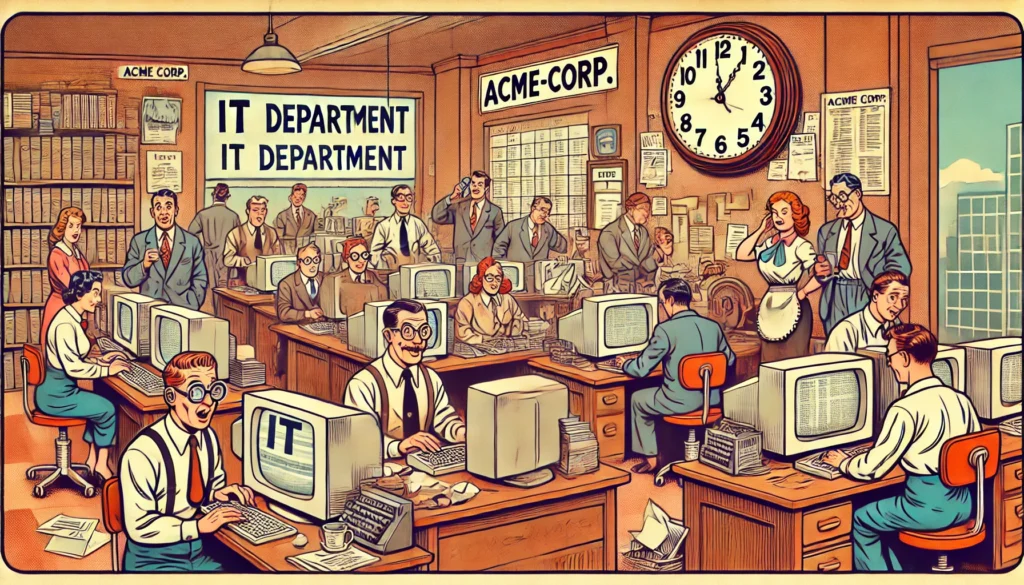Enterprise staffing detailed guide

Previous article: Data leakage prevention in hybrid teams
Many large businesses face challenges with innovation and growth. Employing enterprise staffing can provide the specialized skills and agility needed to overcome these obstacles.
This article explores how to implement enterprise staff augmentation effectively, drive innovation, and overcome integration challenges to achieve sustainable growth.
Enterprise staffing: A complete guide for large enterprise companies — you are here
Understanding the large enterprise staff augmentation role
Many large enterprises use staff augmentation to expedite hiring processes. Strategic applications include:
- Project-based augmentation. For projects requiring unique expertise, such as a tech firm needing cybersecurity specialists.
- Skill gap filling. Integrating professionals to address skill shortages, like data scientists in healthcare.
- Scalability. Adjusting the workforce size based on demand, for instance, increasing customer service reps during peak seasons.
- Global talent access. Accessing skills not available locally, such as blockchain experts.
Benefits of enterprise staffing
Strategic staff augmentation provides large enterprises with several practical benefits, enhancing flexibility, cost management, and access to specialized expertise. Here are the key advantages:
- Flexibility and agility. Enables a rapid response to project demands. Example: Augmented staff can help manage workload surges during peak periods.
- Cost management. Enterprise staffing reduces the costs associated with full-time employees. Example: Savings can be reallocated to innovation projects.
- Specialized expertise. Within staff augmentation companies, you can achieve long term employment goals by accessing to niche skills for specific projects. Example: Hire technology experts for new deployments.
- Enhanced productivity and focus on core competencies. Thanks to external employees, your permanent staff can focus on core tasks. Example: IT departments can hire cybersecurity experts for major overhauls.
- Risk mitigation. Enterprise staffing allows testing of new ideas with minimal risk. Example: Conduct pilot projects with temporary experts without hiring in-house ones.
- Seamless integration. The integration of augmented staff members into your teams is far faster and less challenging. Example: Augmented staff ensures project continuity.
- Global expansion. Closing long term positions with temporary employees, you can test new markets with local experts. Example: Hire local talent without the need to establish offices.
Planning and implementing enterprise staffing

Large enterprise staffing approach is different from smaller companies due to their scale, complexity, and ongoing need for specialized skills. Unlike smaller businesses, they need strategic and scalable solutions to swiftly address skills gaps, manage extensive project pipelines, and maintain a global competitive edge.
Assessing needs using enterprise staffing
Conduct a skills gap analysis
- Evaluate current workforce capabilities. Analyze the skills and expertise within your current team.
Example: A healthcare enterprise might find a shortage of data scientists needed for advanced analytics. - Identify skills shortages. Determine specific areas requiring additional expertise.
Example: A financial services company might need cybersecurity experts for a new digital banking initiative. - Training vs. external expertise. Decide whether to train existing staff or hire externally.
Example: A manufacturing giant might opt to hire robotics engineers for new automation projects.
Review project pipeline and workload forecasts
- Analyze upcoming projects. Evaluate the scope of future projects.
Example: A tech company planning a new product launch might foresee a surge in development needs. - Assess workload. Gauge the expected volume and complexity of tasks.
Example: A retail chain preparing for the holiday season may anticipate increased demand for IT support. - Identify bottlenecks. Pinpoint potential resource constraints.
Example: An aerospace firm may recognize a need for additional software developers to meet deadlines for a new navigation system.
Evaluate technological requirements
- Specialized technical skills. Identify critical technical skills that are lacking.
Example: An automotive company investing in electric vehicles might require battery technology experts. - Emerging technologies. Consider new technologies essential for growth.
Example: A logistics company might need blockchain specialists to enhance supply chain transparency.
Aligning with strategic goals
Define clear strategic objectives
- Articulate goals. Clearly state your organization’s growth and innovation goals.
Example: A pharmaceutical company might aim to accelerate drug discovery processes. - Break down objectives. Translate high-level goals into specific, measurable targets.
Example: Reducing time-to-market for new products by 20%.
Map enterprise staffing needs to strategic priorities
- Direct support. Identify how staff augmentation supports each strategic goal.
Example: Augmented staff could streamline the R&D process for a biotech firm aiming to introduce new treatments. - Prioritize needs. Focus on roles with the highest impact.
Example: Hiring cloud computing experts for a company expanding its digital services.

Develop a flexible enterprise staffing plan
- Scalable strategy. Create a plan that adapts to changing business needs.
Example: A telecommunications company might develop a strategy to scale up customer service teams during product launches. - Short-term and long-term. Balance immediate project requirements with long-term capability building.
Example: A global retailer might temporarily augment its logistics team during peak seasons while investing in long-term automation solutions.
Implementing the alignment strategy
To effectively implement staff augmentation, large enterprises should focus on seamlessly integrating augmented staff into their existing teams.
Create cross-functional teams
- Blend in-house and augmented staff. Form teams that mix internal employees with augmented professionals to facilitate knowledge transfer and innovation.
Establish clear KPIs
- Define performance indicators. Set key performance indicators that link the contributions of augmented staff to strategic goals.
Implement Agile methodologies
- Adopt flexible work processes. Use Agile methods to allow for quick pivots and continuous alignment with evolving business needs.
Invest in integration and onboarding
- Comprehensive onboarding. Develop programs to ensure augmented staff quickly align with company culture and objectives.
Regular review and adjustment
- Periodic assessments. Regularly evaluate the effectiveness of the enterprise staffing strategy and make necessary adjustments.
Foster a culture of collaboration
- Encourage open communication. Promote knowledge sharing between in-house and augmented staff to drive innovation.
Leverage data-driven decision-making
- Use analytics. Track the impact of staff augmentation on strategic goals to inform future decisions.
Choosing the right enterprise staffing partners
Selecting the right staff augmentation partners is critical for meeting the scale and quality requirements of large enterprises. Evaluate potential partners based on the following criteria.
Access experience and expertise
- Industry experience. Choose partners with a proven track record in your industry.
Example: A financial institution might select a partner experienced in fintech. - Project handling. Assess their ability to manage projects similar in scale and complexity to yours.
- Technical expertise. Evaluate their domain knowledge through case studies and portfolios.
Evaluate the quality of talent
- Talent acquisition processes. Examine their methods for sourcing and vetting talent.
- Selection criteria. Inquire about their technical evaluations and background checks as a part of your enterprise staffing strategy.
- Talent pool. Review the qualifications and experience of available professionals.
Check scalability and flexibility

- Resource scaling. Ensure the partner can quickly scale resources to meet project demands.
- Support capacity. Assess their ability to provide both short-term and long-term support.
Review the quality assurance processes
- Control measures. Investigate their quality control methodologies.
- Performance metrics. Ask about their performance metrics and consistency standards.
Consider cultural fit and communication
- Communication style. Evaluate their communication practices and responsiveness.
- Cultural compatibility. Ensure their corporate culture aligns with your organization.
Review security and compliance
- Security protocols. Verify their adherence to industry-standard security measures.
- Regulatory compliance. Ensure compliance with relevant data protection regulations.
Analyze global presence and time zone coverage
- Worldwide support. For global operations, consider partners with international reach.
- Time zone alignment. Ensure they can provide support across various time zones.
Evaluate financial stability
- Financial health. Assess the partner's financial stability to support long-term engagements.
Examine references and reputation
- Client references. Request references from other large enterprises.
- Platform ratings. Review ratings and testimonials on platforms like Clutch or GoodFirms.
Calculate cost-effectiveness
- Pricing structure. Consider their pricing in relation to the value offered.
Assess innovation and thought leadership
- Innovative solutions. Evaluate their ability to provide fresh perspectives and innovative solutions.
Review legal and contractual considerations
- Legal frameworks. Ensure robust legal protections for intellectual property and confidentiality.
Integration strategies
To ensure seamless collaboration when integrating augmented staff into existing corporate structures, consider these best practices.
Tailored onboarding
- Develop onboarding programs specifically for augmented staff, including essential company information and assigning mentors for guidance.
Clear communication channels
- Implement effective communication tools and set clear expectations for communication frequency and methods.
Full team integration
- Introduce augmented staff to the in-house team, involve them in decision-making processes, and ensure they participate in team meetings.
Provide necessary tools
- Ensure all team members have the necessary hardware, software, and collaboration tools, and provide training on these tools.
Cultural respect
- Acknowledge cultural differences and provide resources to navigate these effectively.
Set clear expectations
- Communicate specific skills required, project goals, work hours, engagement duration, and milestones.
Foster collaboration
- Encourage joint work sessions and structured meetings to dive deep into project goals and requirements.

Ongoing support
- Conduct regular check-ins, address challenges promptly, and offer constructive feedback.
Legal and security compliance
- Ensure all contractual agreements, compliance requirements, and cybersecurity protocols are addressed upfront.
Agile methodologies
- Implement Agile practices to promote teamwork and clear communication.
Leveraging augmentation for innovation
Companies are laying off workers and then offering the same jobs to new hires at lower pay, which amounts to a form of ‘tacit collusion’ among major tech firms to depress salaries across the industry.
Slashdot user
Leveraging enterprise staffing allows large enterprises to enhance their projects with fresh ideas and new knowledge. By introducing external professionals with specialized skills and diverse perspectives, companies can drive innovation, overcome internal biases, and accelerate growth.
Fostering an innovative environment
Creating an innovative environment within a large enterprise can be significantly enhanced through the strategic use of augmented staff. For instance, pairing augmented staff with in-house employees from various departments can lead to creative solutions. Imagine a tech firm combining external data scientists with internal product managers to innovate a new AI-driven product. This cross-functional collaboration can spark innovative approaches that might not emerge within a siloed team.
Regular innovation workshops and brainstorming sessions can further stimulate creativity. By organizing these sessions, both augmented and in-house staff can contribute ideas, leveraging techniques like design thinking to solve complex problems. For example, a manufacturing company might use such workshops to explore new production techniques, resulting in breakthrough innovations.
Moreover, establishing an "innovation challenge" program can motivate teams to solve specific business problems. A financial services company might create competitions where mixed teams of augmented and in-house staff tackle challenges, with the winning solutions piloted for broader applications.
Project-based augmentation for R&D

Project-based augmentation is particularly effective in research and development (R&D) initiatives. Consider an automotive company working on electric vehicles. By bringing in augmented staff with expertise in battery technology for specific project phases, the company can tackle complex challenges with confidence. This approach ensures the project benefits from specialized knowledge without the long-term commitment of full-time hires.
Flexibility and scalability are other significant advantages. For example, a tech firm can adjust its team size with augmented staff during peak R&D phases, optimizing resource use and maintaining agility. This model is cost-effective and supports efficient budget management, crucial for variable funding scenarios often seen in R&D.
Additionally, integrating augmented staff can inject fresh perspectives and innovative approaches into projects. An aerospace company, for instance, might bring in external professionals for a new navigation system project, leading to unexpected insights and breakthrough innovations.
Scaling innovation initiatives
To scale innovation efforts without the overhead of permanent expansions, large enterprises can adopt several strategic techniques. One effective method is forming dedicated innovation teams. These temporary, cross-functional teams, augmented with external specialists, can focus on specific innovation initiatives. A tech company, for instance, might rapidly assemble high-powered teams to explore new software solutions, driving innovation without long-term commitments.
Another approach is implementing an "innovation sprint" model, where short-term staff augmentation boosts innovation capacity for defined periods. This method allows companies to inject fresh perspectives and specialized skills into their processes. A media company, exploring new content formats, might use this model to quickly iterate and refine ideas.
Leveraging global talent pools also enhances innovation. By building geographically distributed teams, a global consultancy firm can innovate around the clock, gaining insights from different markets. This approach not only broadens the talent base but also infuses diverse perspectives into the company's innovation efforts.
Moreover, establishing an "innovation lab" structure provides a semi-permanent space for innovation separate from day-to-day operations. A pharmaceutical company might staff this lab with a core team of internal employees and regularly rotate in augmented staff with specialized skills to work on specific projects. This setup ensures a dedicated focus on innovation while maintaining flexibility.
Augmentation for operational efficiency
To improve operational agility, optimize cost management, and enhance productivity through strategic staff augmentation, large enterprises can adopt various approaches. By leveraging external talent and integrating them effectively into their operations, organizations can remain competitive and responsive in rapidly changing business environments.
Improving operational agility
Staff augmentation can significantly enhance the flexibility and responsiveness of operations in large enterprises through several strategies.
Creating flexible teams
- Example: Forming cross-functional teams that combine in-house staff with augmented personnel allows for rapid scaling based on project needs. For instance, a tech firm launching a new product might quickly scale up its development team by adding external software engineers, enabling quick adaptation to evolving business requirements.
- Benefit: This approach ensures that teams can adjust swiftly to changing project demands without the delays associated with traditional hiring processes.
Accessing specialized skills on-demand
- Example: Bringing in experts with niche skills for specific projects allows enterprises to respond promptly to new technological trends or market demands. For example, a financial institution needing blockchain expertise for a new initiative can augment its team with blockchain specialists, reducing the time and cost associated with training internal staff for short-term needs.
- Benefit: This flexibility allows organizations to tackle specialized tasks efficiently and stay ahead of industry trends.
Implementing Agile methodologies
- Example: Using augmented staff to support Agile practices across the organization can enable faster iteration and more responsive product development. A manufacturing company adopting agile methodologies in its supply chain operations can use augmented staff to streamline processes and foster a culture of continuous improvement and adaptation.
- Benefit: This approach enhances the organization's ability to adapt quickly to market changes and customer feedback.
Optimizing cost management
Staff augmentation can be an effective tool for managing costs, particularly in non-core areas of the business.
Reducing overhead costs
- Example: Avoiding long-term commitments and associated costs of full-time employees helps save on benefits, training, and other overhead expenses. A large enterprise outsourcing its IT support to augmented staff can reduce significant overhead costs related to maintaining a permanent team.
- Benefit: This cost-saving measure allows for better allocation of resources to high-value strategic activities.
Flexible resource allocation
- Example: Scaling resources up or down based on project needs and budget constraints ensures optimal resource utilization. A marketing firm can augment its creative team during peak campaign seasons and scale down once the projects are completed.
- Benefit: This flexibility allows organizations to manage budgets more effectively and allocate specialized skills as needed.
Focusing on core competencies
- Example: Outsourcing non-core functions to augmented staff allows internal teams to concentrate on strategic initiatives. A pharmaceutical company, for instance, might use augmented staff for administrative tasks, freeing up its researchers to focus on drug development.
- Benefit: This approach improves overall cost efficiency by optimizing the use of internal resources for high-priority activities.
Enhancing productivity
Strategic staff augmentation can significantly impact overall productivity and efficiency.
Accelerating project timelines
- Example: Bringing in additional resources to speed up project execution can reduce time-to-market for new products or services. For instance, a software company launching a new application can augment its development team to meet tight deadlines.
- Benefit: This strategy enables parallel work streams, increasing overall output and ensuring timely project completion.

Leveraging global talent pools
- Example: Accessing skilled professionals across different time zones can implement follow-the-sun models for 24/7 productivity. A global tech company can use augmented staff from various regions to ensure continuous progress on projects.
- Benefit: This approach taps into diverse skill sets and perspectives, driving innovation and maintaining round-the-clock productivity.
Improving knowledge transfer
- Example: Augmented staff can bring fresh ideas and best practices, facilitating cross-pollination of skills between teams. An engineering firm can enhance its overall skill set by integrating external experts into its projects.
- Benefit: This collaboration enriches the organization’s capabilities and fosters a culture of continuous learning.
Reducing burnout and improving focus
- Example: Using augmented staff to handle peak workloads or specialized tasks allows core teams to focus on strategic initiatives without overwork. A healthcare organization can bring in temporary administrative support during busy periods to maintain consistent productivity levels.
- Benefit: This strategy helps prevent employee burnout and ensures sustained productivity even during high-demand periods.
Managing the challenges of staff augmentation
To effectively manage the challenges of staff augmentation in large enterprises, organizations should focus on cultural integration, maintaining quality and compliance, and long-term relationship management with staffing providers. Here’s a comprehensive approach to addressing the next key areas.
Cultural integration
Integrating external personnel into the entrenched corporate cultures of large organizations can be challenging. Here are strategies to address this.
Comprehensive onboarding
- Application: Develop a tailored onboarding program for augmented staff that includes cultural orientation.
- Example: A financial services company can create a detailed onboarding plan that covers its history, core values, and team dynamics.
- Strategy: Provide clear information about company values, norms, and expectations using interactive methods like workshops and team-building activities to facilitate integration.
Buddy system
- Application: Pair augmented staff with experienced in-house employees to help newcomers navigate the organizational culture and informal networks.
- Example: A tech firm might assign mentors to each new augmented staff member to guide them through their initial weeks.
- Strategy: This personal touch helps augmented staff feel welcomed and supported.
Inclusive communication
- Application: Ensure augmented staff are included in all relevant team communications and meetings.
- Example: A global consultancy firm can use collaboration tools like Slack or Microsoft Teams to facilitate seamless interaction between in-house and augmented staff.
- Strategy: Maintain open channels of communication to integrate external personnel fully into the team.
Cultural awareness training
- Application: Provide training for both in-house and augmented staff on working in diverse teams.
- Example: A multinational corporation might conduct workshops focusing on cross-cultural communication skills and understanding.
- Strategy: This training helps bridge cultural gaps and fosters a more inclusive workplace.
Regular feedback and check-ins
- Application: Implement a system for regular feedback and cultural adaptation check-ins.
- Example: An engineering firm might schedule bi-weekly meetings to address any integration issues proactively.
- Strategy: Continuous feedback ensures that any concerns are addressed promptly, promoting smooth cultural integration.
Maintaining quality and compliance
Ensuring augmented staff adhere to enterprise standards for quality and regulatory compliance is crucial. Here are strategies to achieve this.
Clear documentation and training
- Application: Provide comprehensive documentation of quality standards and compliance requirements.
- Example: A healthcare provider might develop detailed manuals and conduct training sessions on these standards for all augmented staff.
- Strategy: Clear guidelines help ensure everyone understands and meets the required standards.
Integration into existing quality management systems
- Application: Ensure augmented staff have access to and are trained on using the organization’s quality management tools and processes.
- Example: A manufacturing company might integrate external workers into their existing quality assurance processes.
- Strategy: Seamless integration into established systems maintains consistent quality.
Regular audits and assessments
- Application: Conduct periodic audits of work produced by augmented staff to ensure compliance.
- Example: A financial institution might implement quarterly reviews and peer assessments.
- Strategy: Regular checks help maintain high standards and identify areas for improvement.
Contractual obligations
- Application: Include clear quality and compliance requirements in contracts with staffing providers.
- Example: An IT firm might specify performance metrics and penalties for non-compliance.
- Strategy: This ensures accountability and sets clear expectations for quality and compliance.
Continuous monitoring and feedback
- Application: Implement real-time monitoring systems for quality and compliance metrics.
- Example: A logistics company might use software tools to track performance and provide regular feedback.
- Strategy: Ongoing monitoring helps maintain high standards and allows for immediate corrective actions.
Certification and upskilling programs
- Application: Offer opportunities for augmented staff to obtain relevant certifications.
- Example: A pharmaceutical company might sponsor training programs to keep staff updated on evolving compliance requirements.
- Strategy: Continuous learning ensures that augmented staff stay proficient and compliant.
Long-term relationship management
Developing stable and reliable relationships with staffing providers is key to successful staff augmentation. Here are best practices.
Strategic partnership approach
- Application: Treat staffing providers as strategic partners rather than transactional vendors.
- Example: A tech giant might involve providers in long-term planning discussions to align their services with company needs.
- Strategy: This fosters a collaborative environment focused on mutual success.
Regular performance reviews
- Application: Conduct periodic reviews of provider performance against agreed KPIs.
- Example: A retail company might schedule bi-annual performance assessments.
- Strategy: These reviews identify areas for improvement and foster continuous collaboration.
Open communication channels
- Application: Establish clear lines of communication at multiple levels within both organizations.
- Example: A global enterprise might set up regular check-ins to discuss ongoing projects, challenges, and opportunities.
- Strategy: Transparent communication ensures alignment and quick resolution of issues.
Collaborative problem-solving
- Application: Involve providers in addressing challenges and developing solutions.
- Example: A telecommunications firm might hold joint workshops to brainstorm and resolve project roadblocks.
- Strategy: Shared responsibility for project success builds stronger partnerships.
Knowledge sharing
- Application: Create mechanisms for sharing industry insights and best practices with providers.
- Example: A financial services company might host quarterly knowledge exchange sessions.
- Strategy: This mutual understanding improves service quality and provider alignment with company needs.

Long-term contracts with flexibility
- Application: Negotiate longer-term contracts that provide stability but include clauses for flexibility.
- Example: A manufacturing firm might draft contracts allowing for adjustments based on changing business needs.
- Strategy: Stability with built-in flexibility ensures both parties can adapt to evolving requirements.
Invest in relationship-building
- Application: Organize joint workshops, training sessions, or social events.
- Example: An engineering company might host annual retreats to strengthen the relationship with their staffing providers.
- Strategy: These activities build trust and understanding between the organization and providers.
Conclusion
Strategic staff augmentation enhances capabilities, drives innovation, and maintains efficiency in large enterprises. Effective integration, quality and compliance standards, and long-term partnerships with staffing providers ensure success. By adopting these strategies, enterprises can maximize staff augmentation benefits, improve agility, manage costs, and enhance productivity.
Egor Kaleynik
IT-oriented marketer with B2B Content Marketing superpower. HackerNoon Contributor of the Year 2021 Winner – MARKETING. Generative AI enthusiast.
Featured in: Hackernoon.com, Customerthink.com, DZone.com, Medium.com/swlh
More info: https://muckrack.com/egor-kaleynik